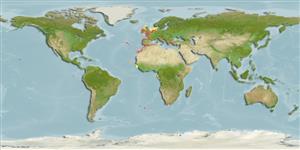Common names from other countries
Classification / Names / Names
Nombres comunes | Sinónimos | Catalog of Fishes (gen., sp.) | ITIS | CoL | WoRMS
Environment: milieu / climate zone / depth range / distribution range
Ecología
. Temperate
Atlantic and the Mediterranean: Great Britain to Equatorial Guinea. Temperate to tropical climates.
Length at first maturity / Tamaño / Peso / Age
Maturity: Lm ? range ? - ? cm
Known from infra- and circalittoral zones. Solitary (Ref. 2377).
Life cycle and mating behavior
Madurez | Reproducción | Puesta | Huevos | Fecundidad | Larva
Members of the class Anthozoa are either gonochoric or hermaphroditic. Mature gametes are shed into the coelenteron and spawned through the mouth. Life cycle: The zygote develops into a planktonic planula larva. Metamorphosis begins with early morphogenesis of tentacles, septa and pharynx before larval settlement on the aboral end.
Wirtz, P., O. Ocaña and T. Molodtsova. 2003. (Ref. 201)
IUCN Red List Status (Ref. 130435)
CITES status (Ref. 108899)
Not Evaluated
Not Evaluated
Threat to humans
Harmless
Human uses
| FishSource |
Herramientas
Más información
Age/Size
Crecimiento
Length-weight
Length-length
Morfología
Larva
Abundancia
Fuentes de Internet
Estimates based on models
Preferred temperature
(Ref.
115969): 11.4 - 19, mean 12.5 (based on 78 cells).
Price category
Unknown.
